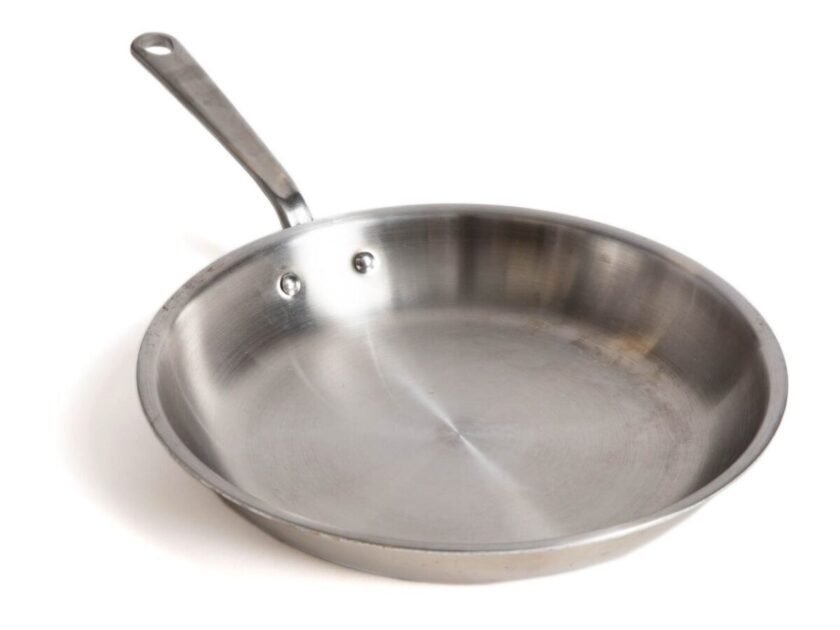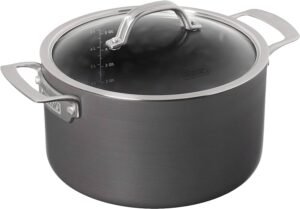To use a stainless steel frying pan, preheat the pan before adding any food and use medium to moderate heat to avoid damage. Remember to use enough oil to prevent sticking and to be patient while cooking.
Preparation
Before you start using your stainless steel frying pan, preparing it for cooking correctly is essential. This includes preheating the pan, using heat, and choosing the right cooking fat. Following these steps ensures that your food is cooked evenly and sticks less to the pan, making for a more enjoyable cooking experience.
Preheating The Pan
To ensure that your food cooks evenly and prevents sticking, it’s crucial to preheat your stainless steel frying pan. Just like preheating an oven before baking, preheating your pan allows for better heat distribution throughout the cooking surface. This step is crucial if you’re cooking ingredients that require high heat, such as searing meat or stir-frying vegetables.
Here’s how to preheat your pan:
- Place the stainless steel frying pan on the stove over medium heat.
- Allow the pan to heat up for a few minutes until it feels warm.
- You can perform a “bead test” to check if the pan is hot enough. Drop a small amount of water onto the cooking surface, and if the water immediately forms into tiny beads and evaporates, the pan is ready for cooking.
Using The Right Heat
The correct heat level is essential when cooking with a stainless steel frying pan. Too much heat can cause food to burn or stick to the pan, while too little heat can result in uneven cooking and longer cooking times.
Here are some tips for using the proper heat:
- Start by using medium to moderate heat for most cooking purposes. This allows even heating without risking damage to the pan or your food.
- If you need to sear meat or cook ingredients quickly, you can increase the heat to medium-high. Just monitor the heat and adjust as necessary to prevent burning.
- Avoid using high heat unless necessary, as this can lead to food sticking to the pan and difficulty cleaning.
Choosing The Right Cooking Fat
The type of cooking fat you use can significantly affect your dish’s cooking process and outcome. When using a stainless steel frying pan, it’s essential to choose a cooking fat with a high smoke point to prevent it from burning and releasing harmful fumes.
Consider these tips for choosing the right cooking fat:
- If cooking over high heat, opt for oils with high smoke points, such as grapeseed or sunflower oil.
- If you’re cooking over medium heat, olive oil is a great option, as it has a lower smoke point but still works well at moderate temperatures.
- Avoid using cooking sprays, as they can leave a residue on the pan that can be difficult to clean.
By preheating your pan, using the proper heat, and selecting the appropriate cooking fat, you’ll set yourself up for successful cooking experiences with your stainless steel frying pan. These simple steps will help ensure your food is cooked evenly and doesn’t stick to the pan, making your cooking adventures more enjoyable and stress-free.
Cooking Techniques
When it comes to cooking with a stainless steel frying pan, there are various techniques you can employ to achieve delicious and mouthwatering results. Whether you are looking to sear, brown, deglaze, stir-fry, or sauté, having a good understanding of these cooking techniques is essential for achieving the perfect meal. This article will explore these techniques in detail, providing valuable tips and tricks. So, let’s dive in:
Searing And Browning
Searing and browning are two crucial techniques that enhance the flavor and texture of your food. Ensure your stainless steel frying pan is adequately preheated to achieve a flavorful sear. Heat the pan over medium heat for a few minutes until it reaches the desired temperature. Next, add a small amount of high-smoke point oil, such as grapeseed or sunflower oil, to the pan and swirl it around to coat the surface evenly. Then, carefully place your protein or vegetable in the pan, ensuring not to overcrowd it. Allow the food to develop a golden-brown crust without constant flipping or stirring. This will help to lock in the juices and create a delicious caramelized exterior.
Deglazing
Deglazing is a beautiful technique for creating flavorful sauces or gravies. After searing or browning your food, please remove it from the pan and set it aside. With the heat still on, add a liquid, such as broth, wine, or vinegar, to the hot pan. Using a wooden spoon, scrape the browned bits from the bottom of the pan, allowing them to dissolve and infuse the liquid with rich flavors. This process adds depth and complexity to your dishes and helps to create a mouthwatering sauce that perfectly complements your meal.
Stir-frying
Stir-frying is a quick and healthy cooking technique that allows you to retain your ingredients’ natural flavor, color, and crispness. To stir-fry with a stainless steel frying pan, preheat the pan over high heat until hot. Add a high-smoke point oil, such as peanut or sesame oil, and swirl it around to coat the surface evenly. Add your sliced vegetables, meat, or tofu to the pan and continuously toss and stir them using a spatula or tongs. The high heat and quick cooking time ensure that your ingredients cook evenly and retain their vibrant colors, creating a delicious and nutritious stir-fry.
Sautéing
Sautéing is a versatile cooking technique that lets you cook your ingredients quickly while retaining their natural flavors and textures. To sauté using a stainless steel frying pan, preheat the pan over medium heat until hot. Add a small amount of oil or butter to the pan and swirl it around to coat the surface evenly. Add your diced or thinly sliced ingredients, such as onions, garlic, or mushrooms, and cook them while continuously stirring. The even heat distribution of the stainless steel pan ensures that your ingredients cook evenly and develop a beautiful caramelized exterior.
Cleaning And Maintenance
Discover the proper way to use a stainless steel frying pan with these essential tips. Preheat the pan before cooking, use moderate heat, and add enough oil to prevent sticking. Follow these steps for a successful cooking experience with your stainless steel pan.
Removing Stains And Food Residue
To keep your stainless steel frying pan looking pristine and in top condition, it’s essential to know how to effectively remove stains and food residue.
- Start by rinsing the pan with warm water to remove any loose debris.
- If there are stubborn stains or burnt-on food, create a paste using equal parts baking soda and water.
- Apply the paste to the affected areas and let it sit for a few minutes.
- Gently scrub the pan with a non-abrasive sponge or cloth, moving in circular motions.
- Rinse the pan thoroughly with warm water to remove any residue.
- You can try using white vinegar or lemon juice if there are still stubborn stains.
- Apply a small amount of vinegar or lemon juice to a cloth and gently rub the stained areas.
- Rinse the pan once again with warm water to remove any remaining residue.
Avoiding Abrasive Cleaners
While reaching for abrasive cleaners to tackle tough stains can be tempting, avoiding using them on your stainless steel frying pan is essential. Abrasive cleaners can scratch the pan’s surface, compromising its performance and lifespan.
- Avoid using steel wool or harsh scouring pads, which can create scratches.
- Instead, opt for non-abrasive sponges or soft cloths to clean your pan.
- If you encounter stubborn stains or food residue, refer to the previous section on removing stains and food residue.
- You can use gentle cleaning methods to ensure that your stainless steel frying pan remains in optimal condition for years.
Drying And Storing
Properly drying and storing your stainless steel frying pan prevents water spots, rust, and corrosion.
- After washing your pan, dry it thoroughly with a clean towel or cloth.
- Avoid air drying, which can lead to water spots and potential damage.
- Once dry, store your pan in a well-ventilated area to prevent moisture accumulation.
- Avoid stacking other cookware on top of your stainless steel frying pan, which can cause scratching.
- If you need to stack your pans, use pan protectors to prevent scratching.

Frequently Asked Questions On How To Use A Stainless Steel Frying Pan
How Do You Keep Food From Sticking To Stainless Steel Pans?
To keep food from sticking to stainless steel pans, follow these guidelines: Preheat the pan before adding oil, use oil with a high smoke point, such as grapeseed or sunflower, avoid cooking sprays, and add a thin layer of oil to the pan.
Additionally, cook over medium heat and be patient.
How Do You Keep Eggs From Sticking To Stainless Steel Pans?
Preheat the pan before adding eggs to keep eggs from sticking to stainless steel pans. Use enough cooking oil with a high smoke point. Avoid cooking sprays. Cook the eggs over medium heat. Be patient, and avoid moving eggs too soon.
Do you use a stainless steel fry pan for the first time?
To use a stainless steel frying pan for the first time, preheat it before adding any food. Use medium to moderate heat and add enough oil to prevent sticking. Be patient and avoid using cooking sprays.
What Is The Trick To Cooking With Stainless Steel?
To cook with stainless steel, follow these tips: 1. Preheat the pan before adding oil, ensuring even heat distribution. 2. Use oil with a high smoke point for high heat cooking, like grapeseed or sunflower oil. 3. For medium heat, olive oil is suitable.
4. Avoid cooking sprays, which create a sticky layer on the pan. 5. Always preheat the pan before cooking to prevent sticking.
Conclusion
It is appropriately preheated before adding any food. This helps to prevent food from sticking to the surface. Additionally, using enough oil and keeping the temperature high can also contribute to a successful cooking experience with stainless steel frying pans.
Be patient and allow the pan to heat up before adding the ingredients. By following these simple tips, you can make the most of your stainless steel frying pan and enjoy delicious meals without any sticking or fuss.
Happy cooking!

Hi, I’m Esrat, and I’m so glad that you found me here at Happy Food Kitchen! I started Happy Food Kitchen in 2023 to have a creative, right-brained outlet to balance my very left-brained career in genetics.





